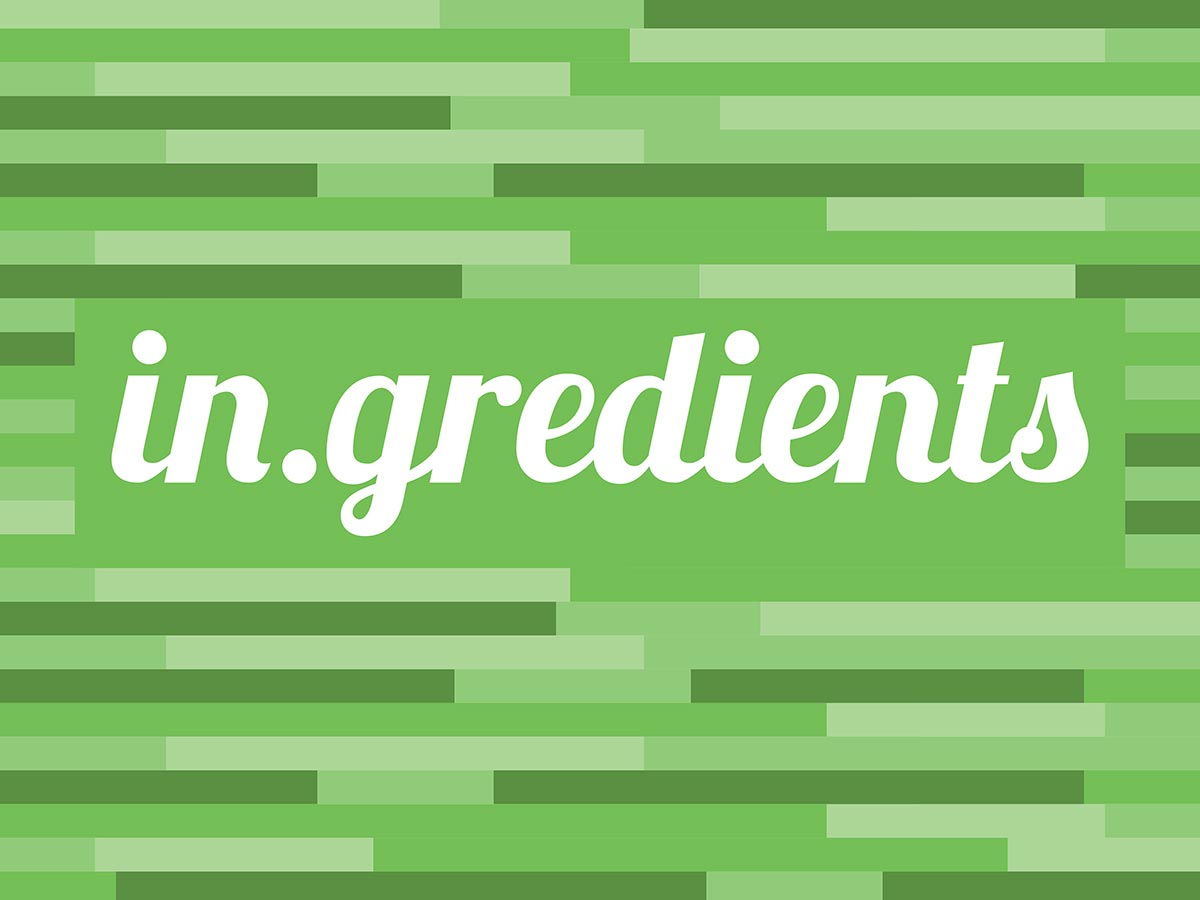Project Overview
Sustainable & Local
Located in East Austin, in.gredients is a zero waste grocery store that provides local and seasonal produce, bulk items, and prepared foods. in.gredients also has live music, trivia nights, and hosts events and workshops for the surrounding community.
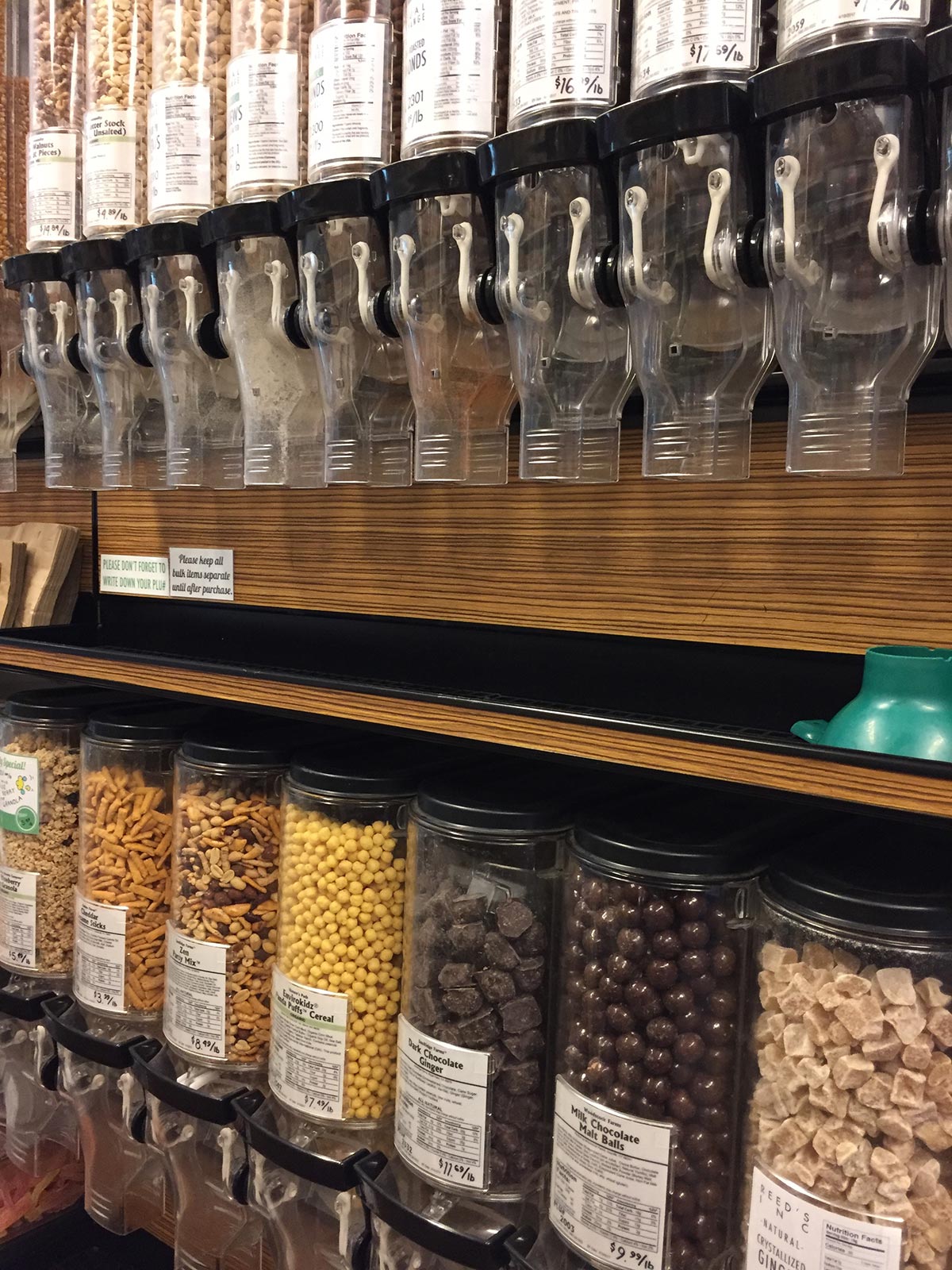
Participants
Working with the staff on provided information about the ways in which the store educates the customers about the store ethos and how the mission of the store contributes to the overall customer experience.
Objective
A project for in.gredients should entice repeat customer participation to help develop a lasting impression on the importance of the mission of in.gredients—to reduce landfill waste and promote local and sustainable food. The challenge is to break old customer habits of buying unsustainable foods and help them form new habits of shopping responsibly.
Research Methods
Direct Observations
For the initial research phase, direct observation of the store and the people shopping required taking photographs and writing notes about things happening at the store. I also went to the store to shop bringing my own containers, and without in order to experience the store as a brand new customer and as a veteran shopper who fully embraces the in.gredients ethos.
While visiting the store, I took note of the existing branding of in.gredients as well as the materials used throughout the store in order to establish a design language for the eventual solution.
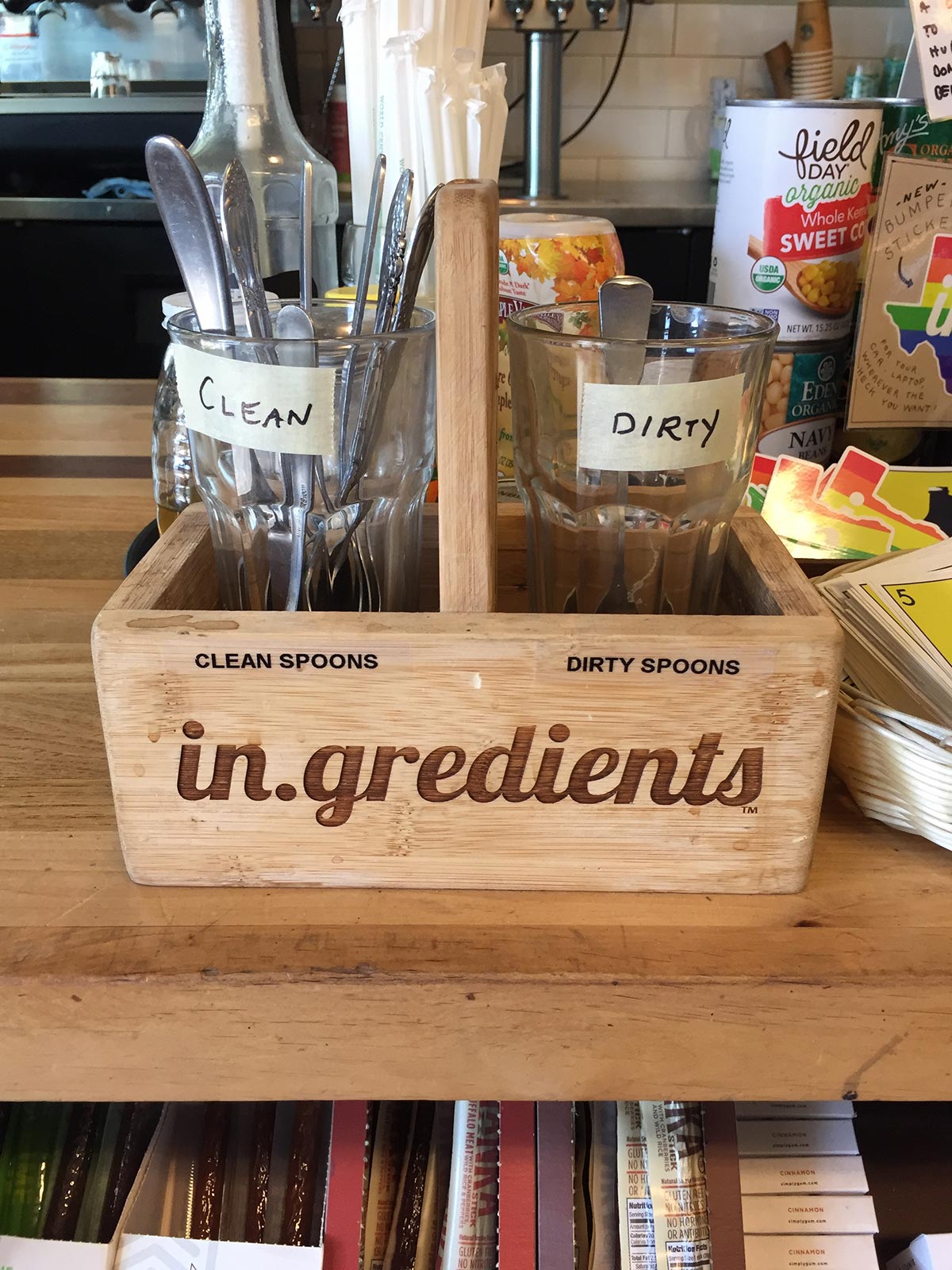
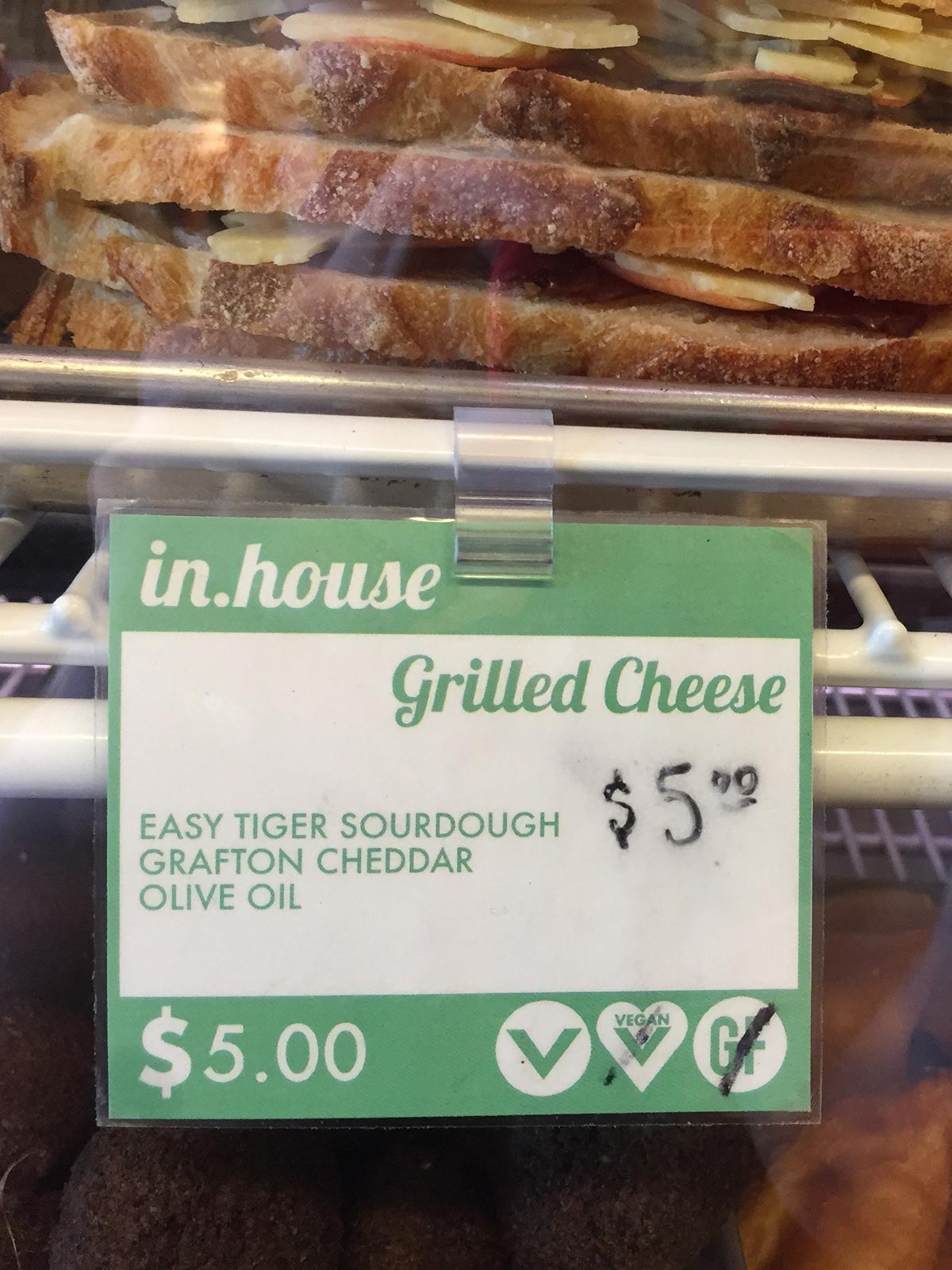
Survey
The in.gredients staff was prompted to participate in a short story in order to figure out the sustainable grocery practices and buying habits of the people who actually work at the store since they are most likely to embody the store ethos. The survey also asked the employees to list all the items they knew were on the banned ingredients list to see how their answers compared to the items from the full list.
A recent customer survey had been given to around 80 people who shop at in.gredients and the results were shared to supplement the research.
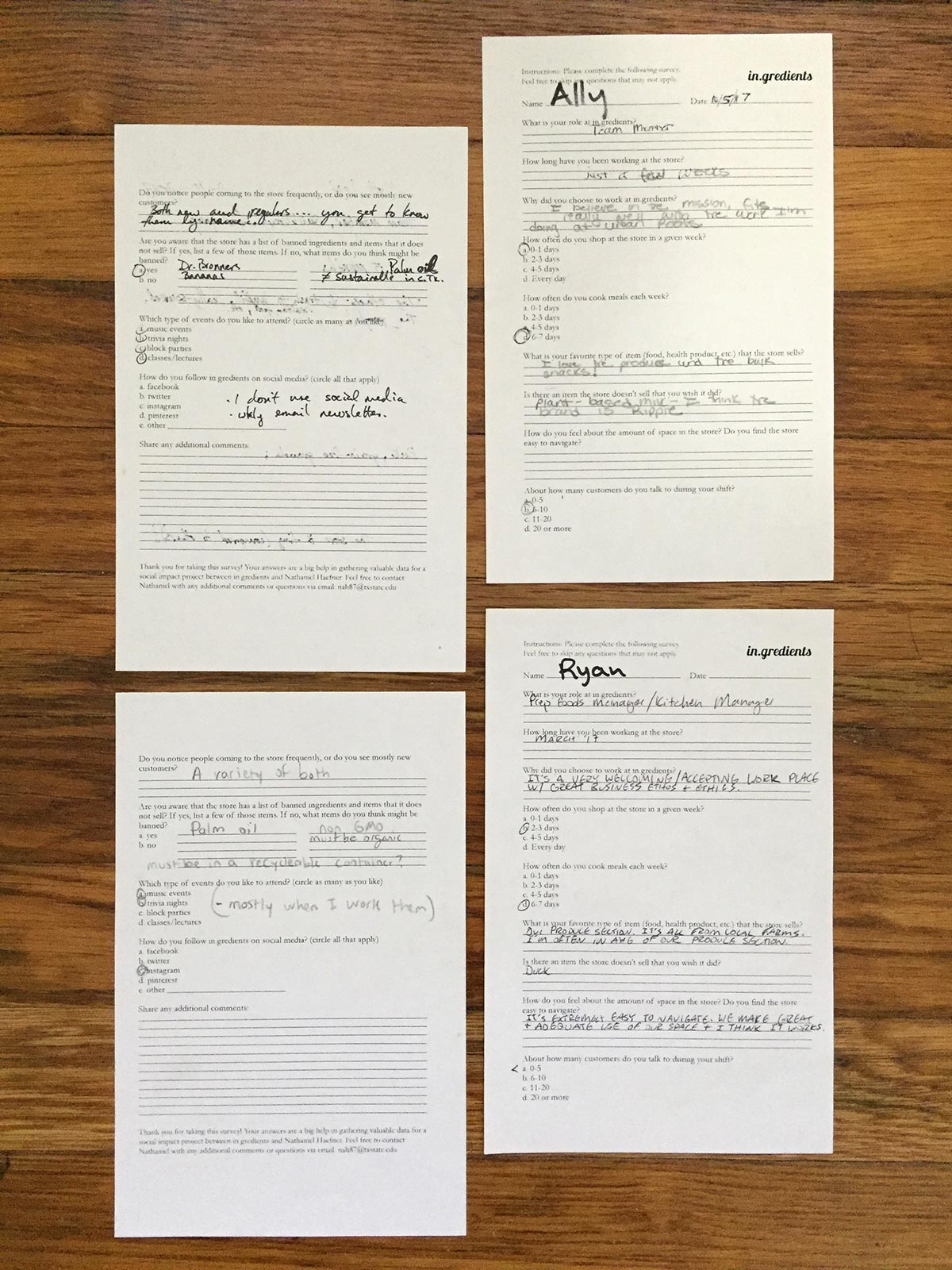
Participatory Card Exercise
Using a deck of cards containing common ingredients for sale in the store and a modifying card showing an attribute, the in.gredients staff and a few customers participated in a game intended to discover the optimal type of packaging to hold items purchased in the store. The deck of cards contained 24 different foods and products and 6 attribute cards.
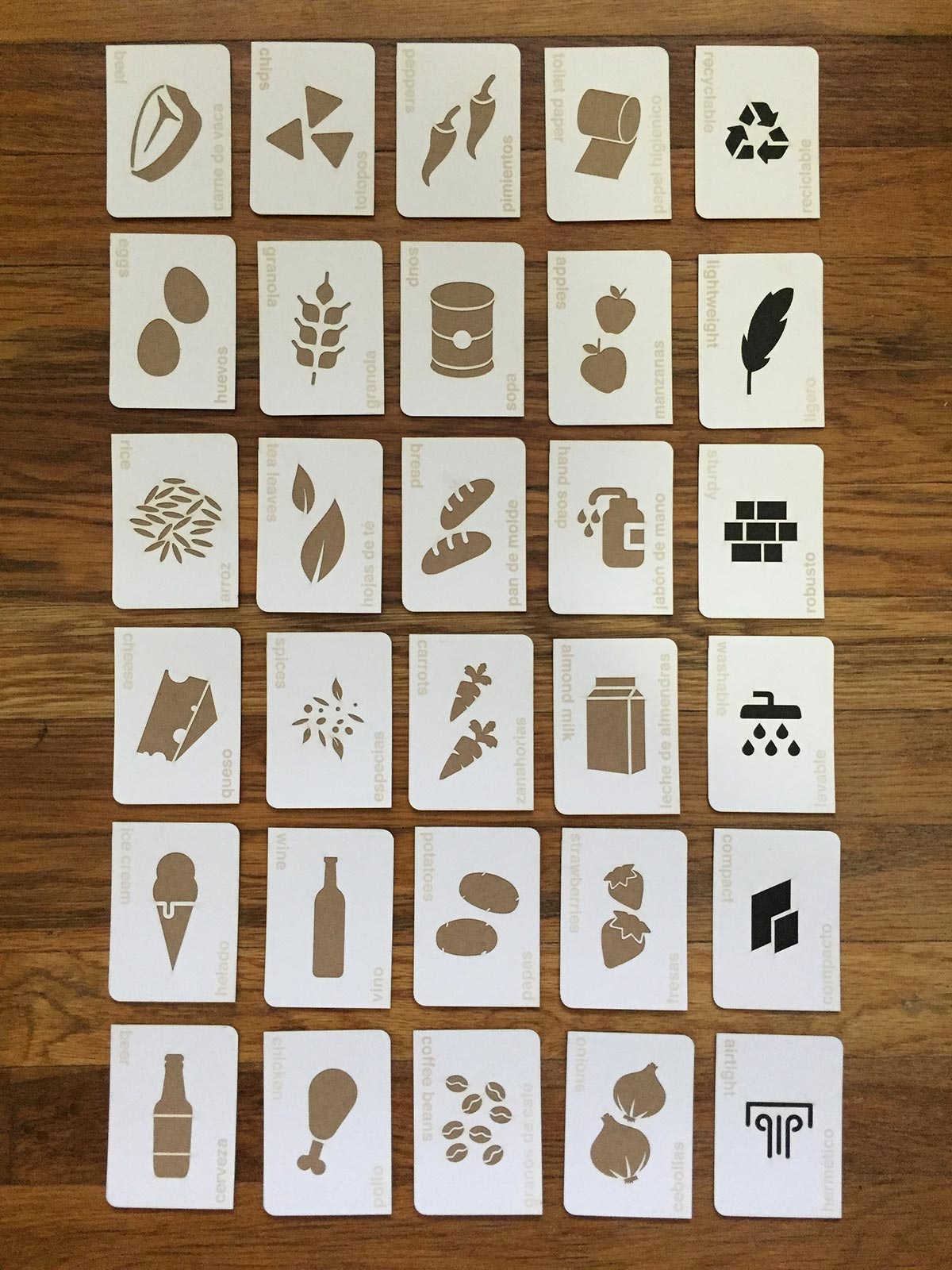
Playing the Game
For 2 minutes, each person would draw or diagram a type of container that would hold each of the 4 ingredient cards that also takes on the property of the attribute card. Then each person would explain their design solution. For subsequent rounds, new cards would be drawn until all the cards had been used and many unique solutions had been generated.
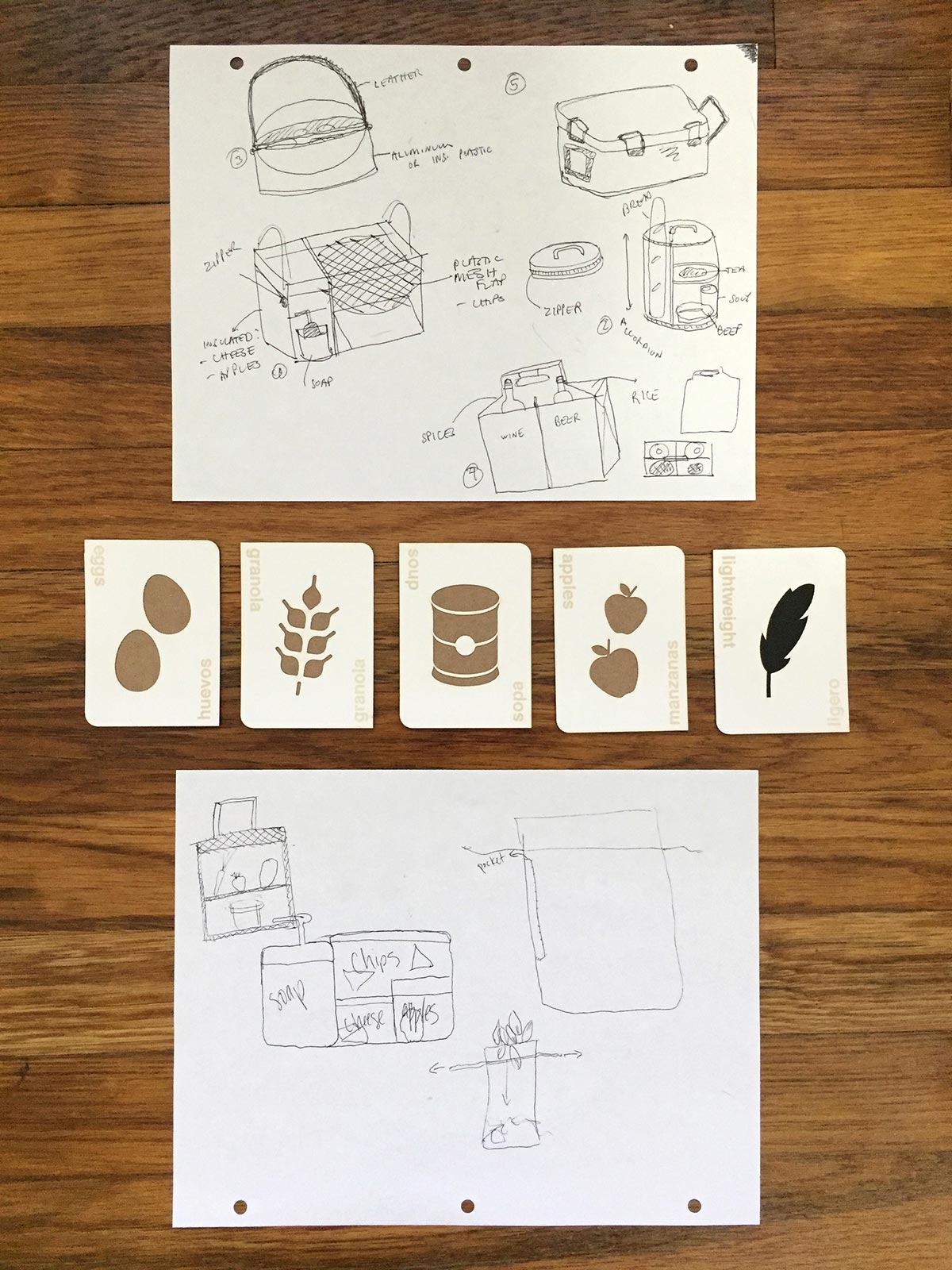
Research Results
Customer Statistics
The goal was to research the customer experience and how customers are educated about the store ethos. The largest demographic of customers are between the ages of 25 and 34, visit the store because of the mission/ethos and location, and shop 2 – 3 time a month or less at the store.
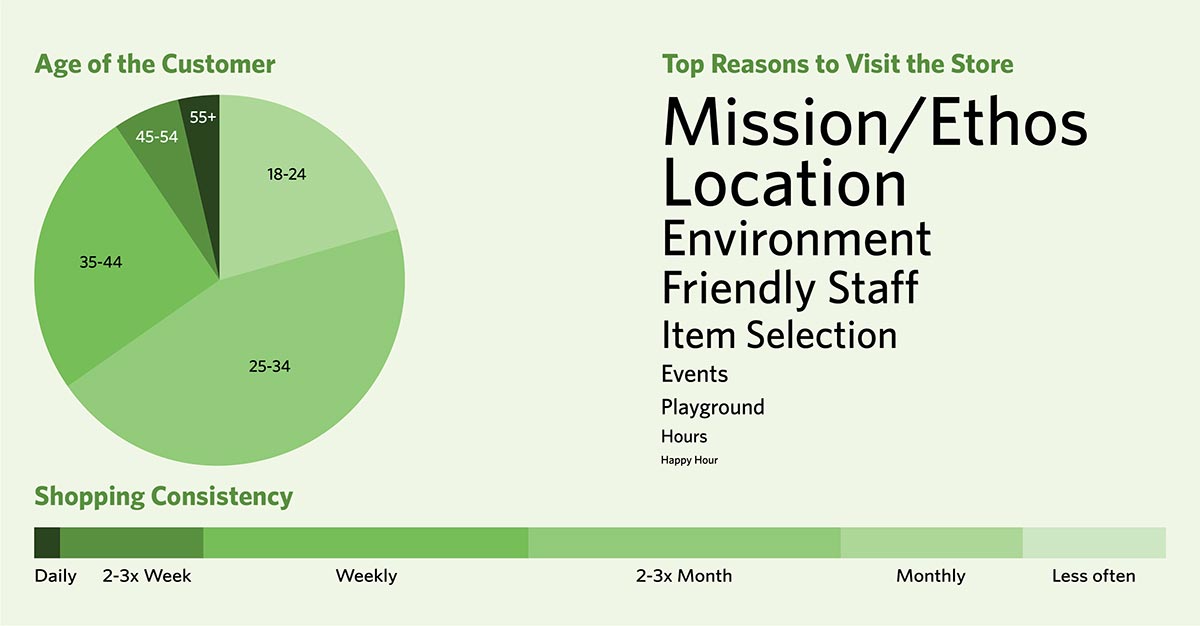
Containers
Options in the Store
When customers forget their containers, the options are generic jars from $1.20 – $2.50 or plastic bins are available for 30¢, 40¢, and, 50¢ based on the size. The jars are on one side of the store and the plastic bins are sold near the weigh station.
Also, small brown paper bags and small plastic bags are available to customers in store. A customer can bring in any clean container and weight at the tare station before filling it with bulk items. Often, a customer will use a large plastic bag and only fill it with a small amount of bulk food.
“The best containers to bring into the store are glass and clear plastic, because studies have shown that food stored in clear containers are more likely to be eaten and used before they go bad.”
—Grayson, Content Lead/Marketing Director
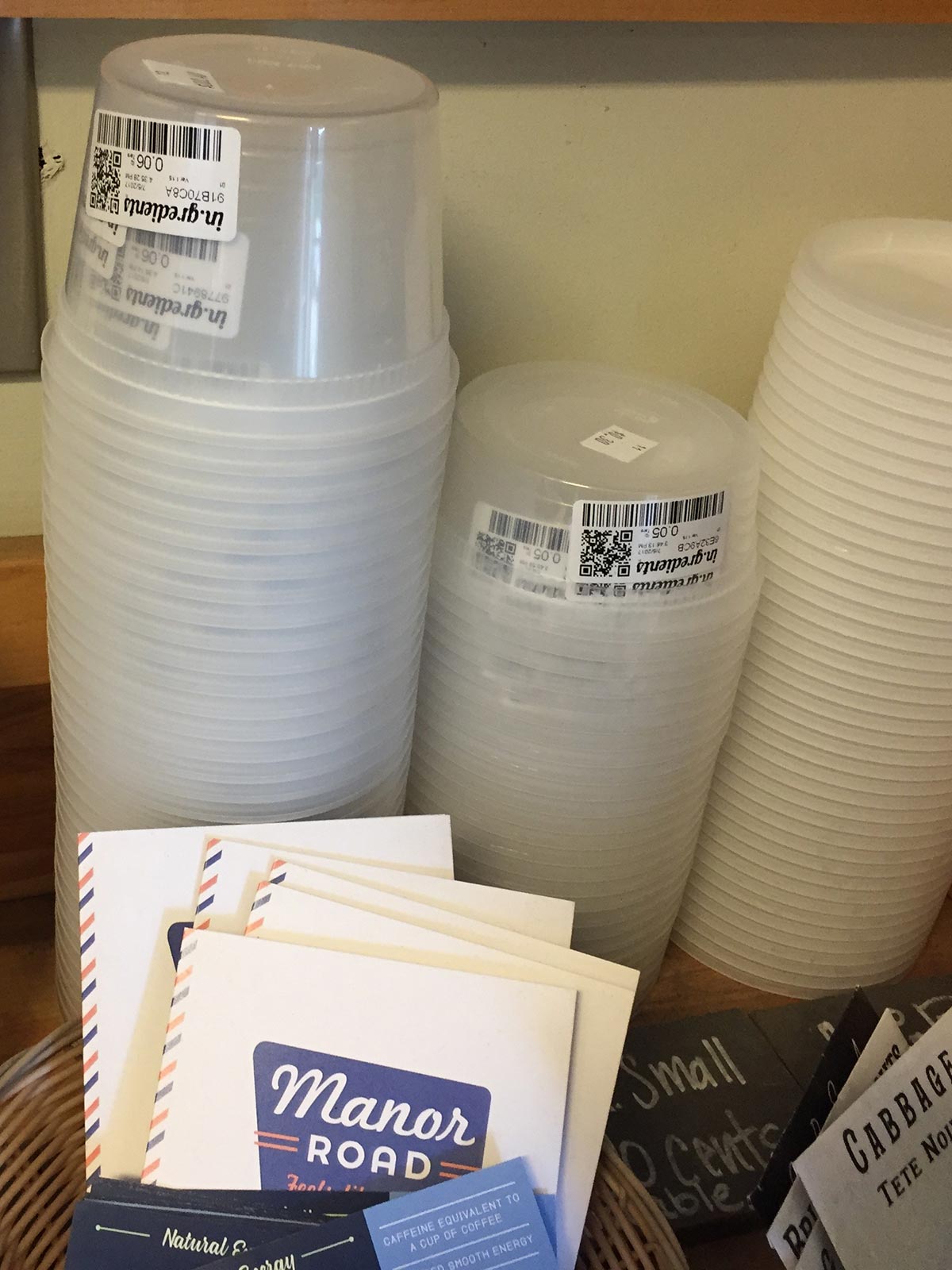
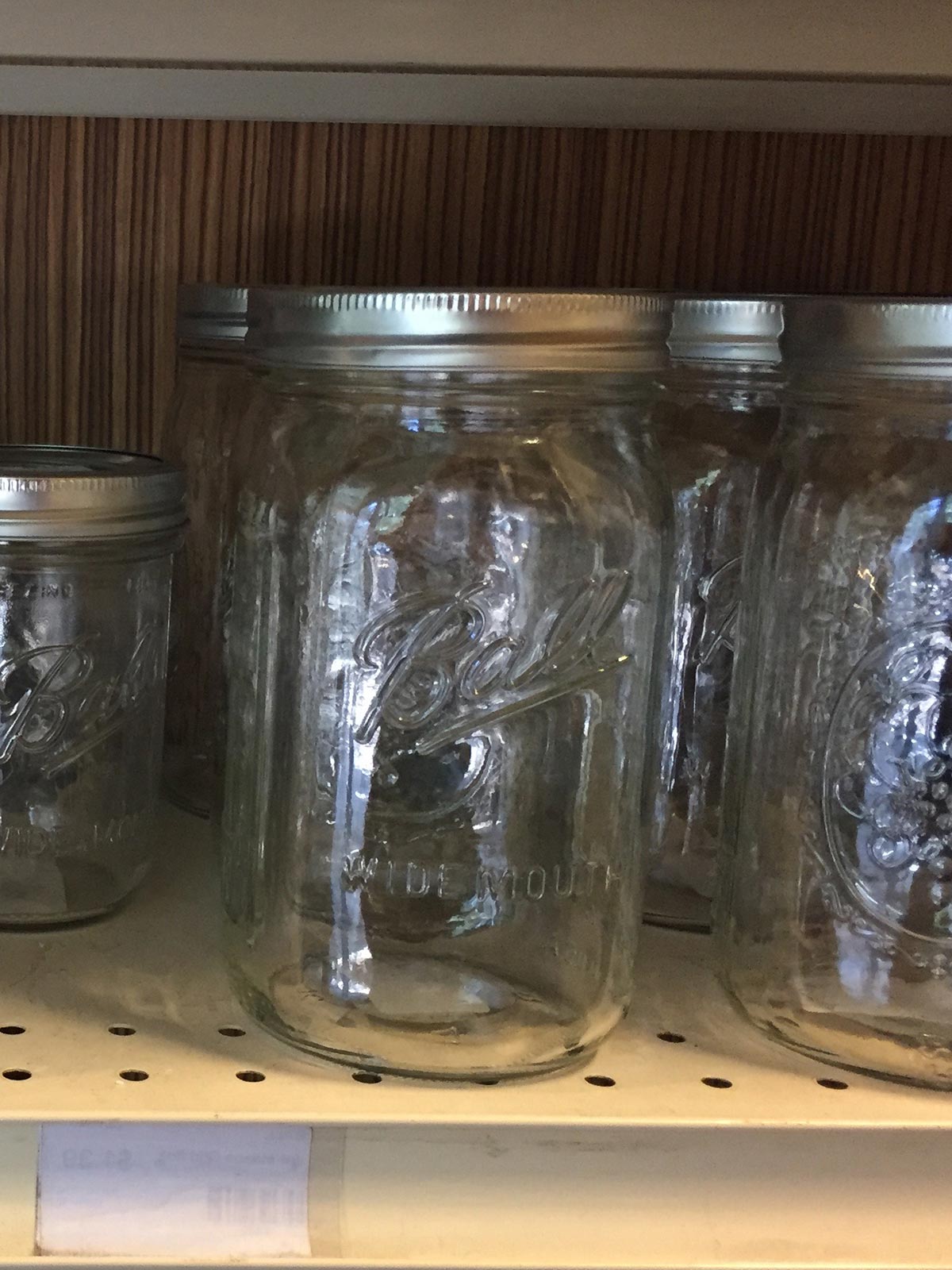

Banned Ingredients
The unacceptable ingredients list is a list of all banned items that in.gredients will not sell. All of the items in their store are free from any of the chemicals and colors from the list.
Only a small number of the ingredients on the list were named by the employees in the survey. Also, some employees named items that were not on the list.
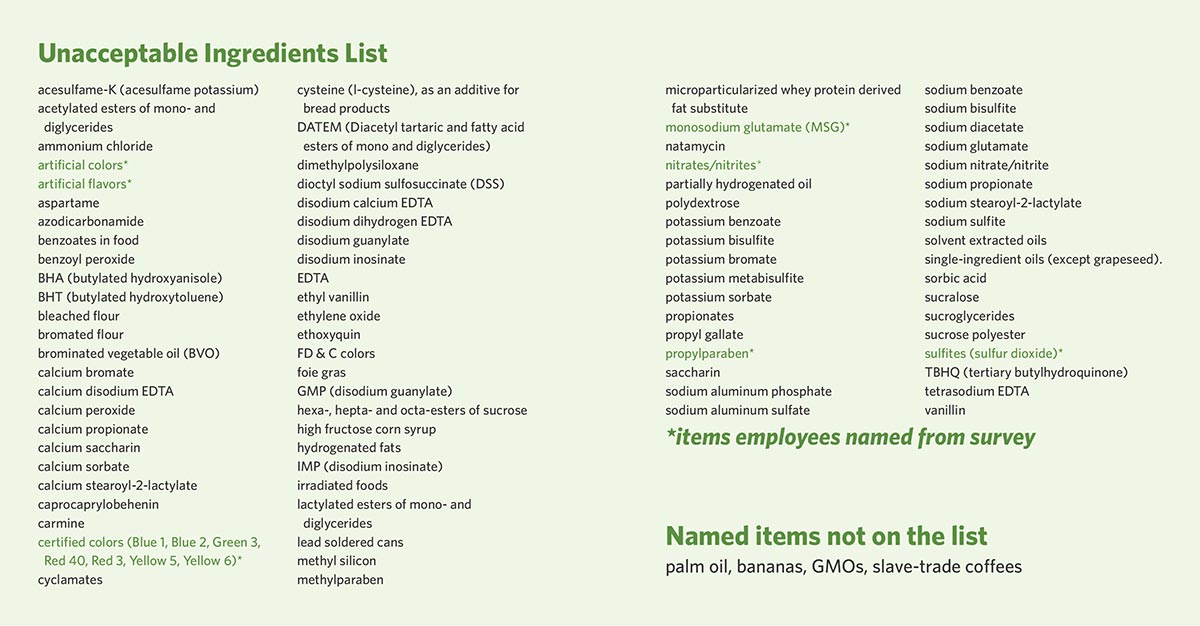
Research Conclusion
Since the ethos and mission are the biggest draw for customers visiting the store, and a majority of the customers visit the store on less than a weekly basis, a reasonable design solution would emphasis the ethos and promote customer engagement and retention. Teaching customers more about what items in.gredients allows in the store and where those items come from, especially the locally grown produce, would also engage customers more and give them a more personal connection to the local grocer.
Another aspect of shopping that is more unique to in.gredients is the process of bringing containers rather than using containers provided by the store. The current jars and plastic containers are lacking in branding and do not provide any reminders for the customer about where the item came from or that the container can be reused again and again. They are also not always located in the most accessible area of the store.
The staff of in.gredients is highly knowledgeable of the quality and sustainability aspects of their food and home goods, but the information is not always passed along directly to the customer unless the customer inquires about it. Most of the direct engagement for customers comes from attending frequent events hosted at the store. These events provide the largest opportunity to promote new programs or practices and reach the largest audience.
In researching the sustainable practices that the store itself follows, there were a few things that had the potential to be improved upon. The main culprit of landfill trash generated at the store comes from either customers brining outside trash into the store in the form of non-reusable containers or from the non-recyclable backing paper from stickers. By reminding people to bring proper containers and by also reusing the same containers, both sources of trash could be reduced.
Design Solution
Subscription Service
The solution is to provide a subscription service that lets customers rely on the knowledge of the in.gredients staff to create weekly boxes of food and other products, which can be collected by the customer. The customer will simply sign up in person or through the website and come to the store to pick up a sustainable box of food in branded, reusable containers.
Subscribers will pay for a month’s or more of weekly boxes that will not only provide them more convenient access to seasonal produce, but also interesting recipes, promotional items, and special jars and containers to use again and again at the store.
The weekly food and item boxes reinforce the store ethos and mission. The box comes with reusable containers to get customers used to bringing in their own containers for buying bulk, which will help reduce the entrance barrier to sustainable shopping practices at the store.
Customers will engage in sustainable practices along with the store by returning empty boxes and jars for reuse. Incentives will be provided to customers who frequently return the empty items, which will enhance the participation of subscribers.
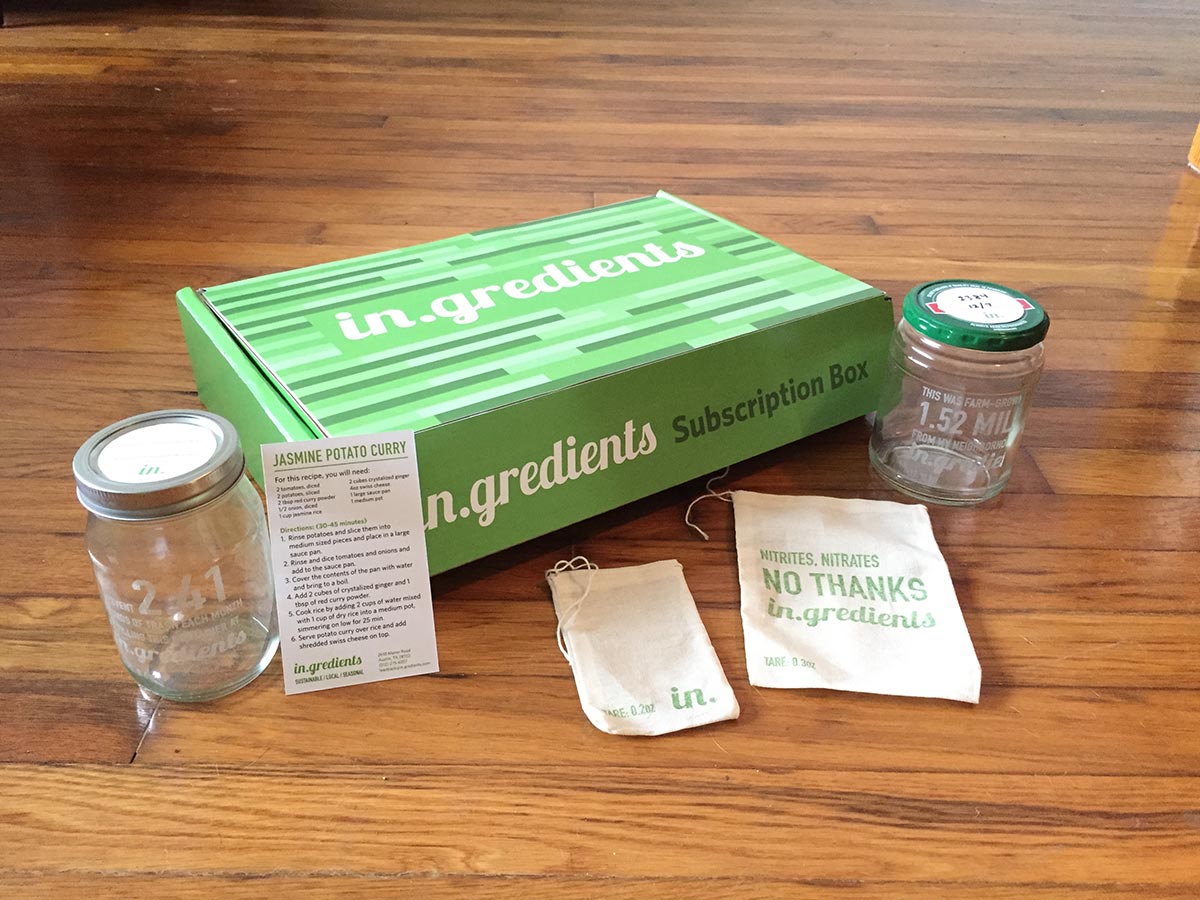
Subscription Box
Waxed cardboard boxes are reusable and can hold a variety of produce, jars of bulk items, and refrigerated items. They can be folded flat when unused to reduce the amount of space used to store them. Recipe cards containing the contents of the box are included in a moisture resistant pocket. The box features the branding of the store as well as directions on how to return the box when empty.
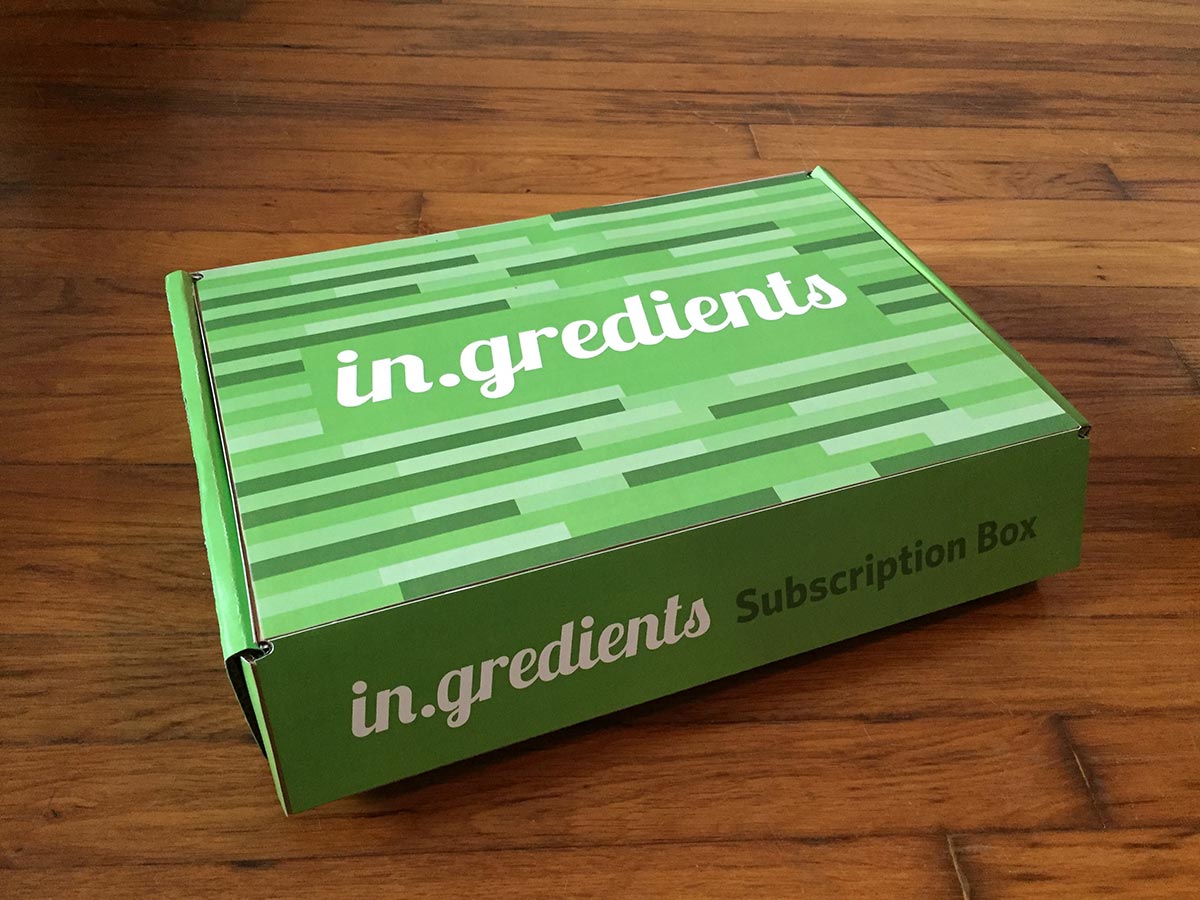
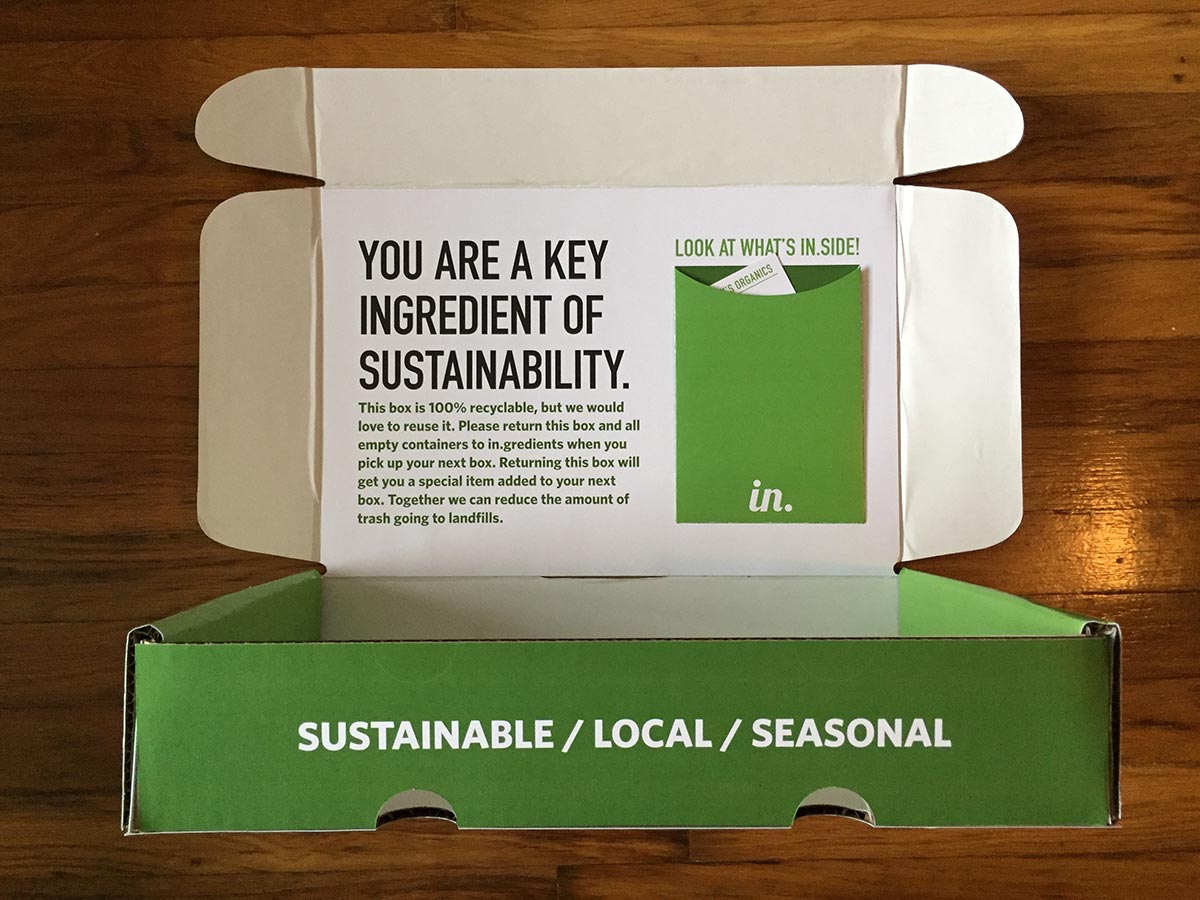
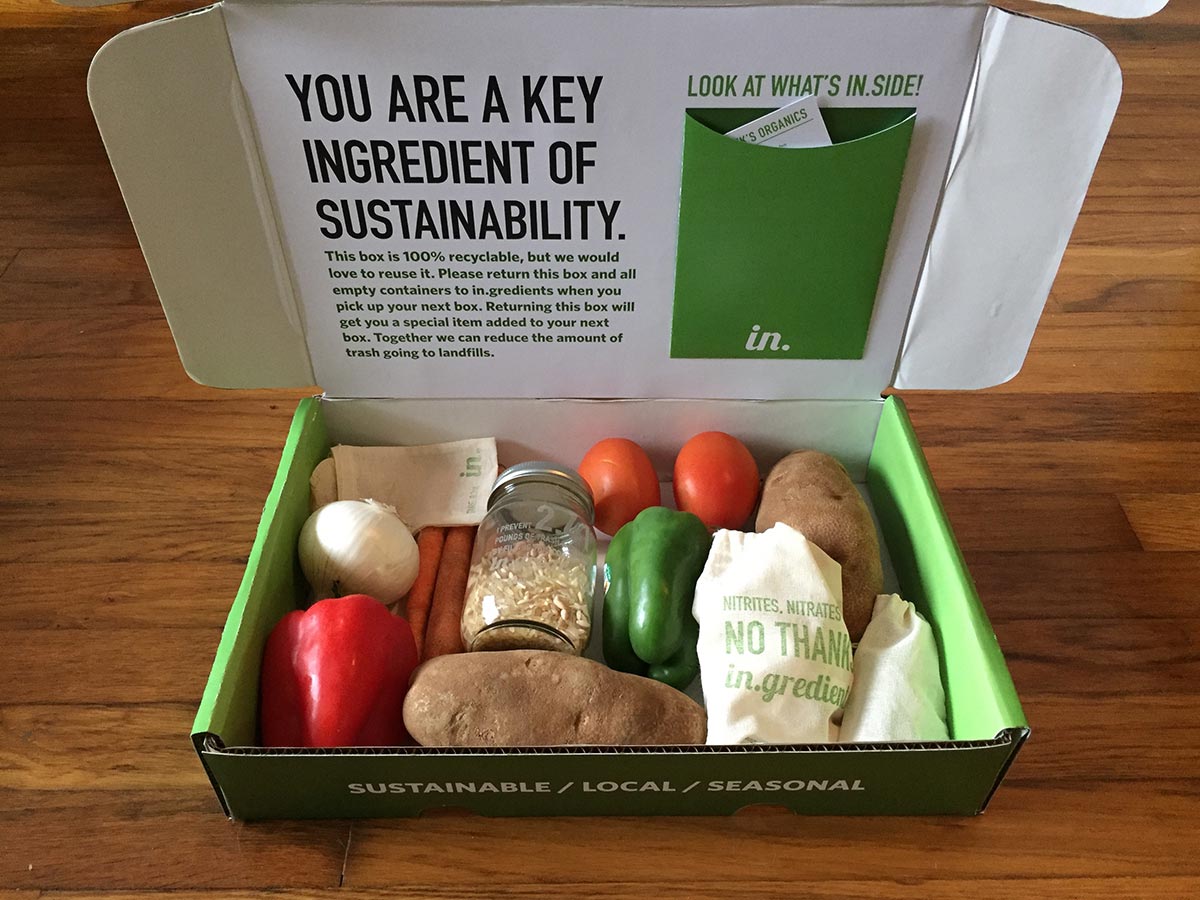
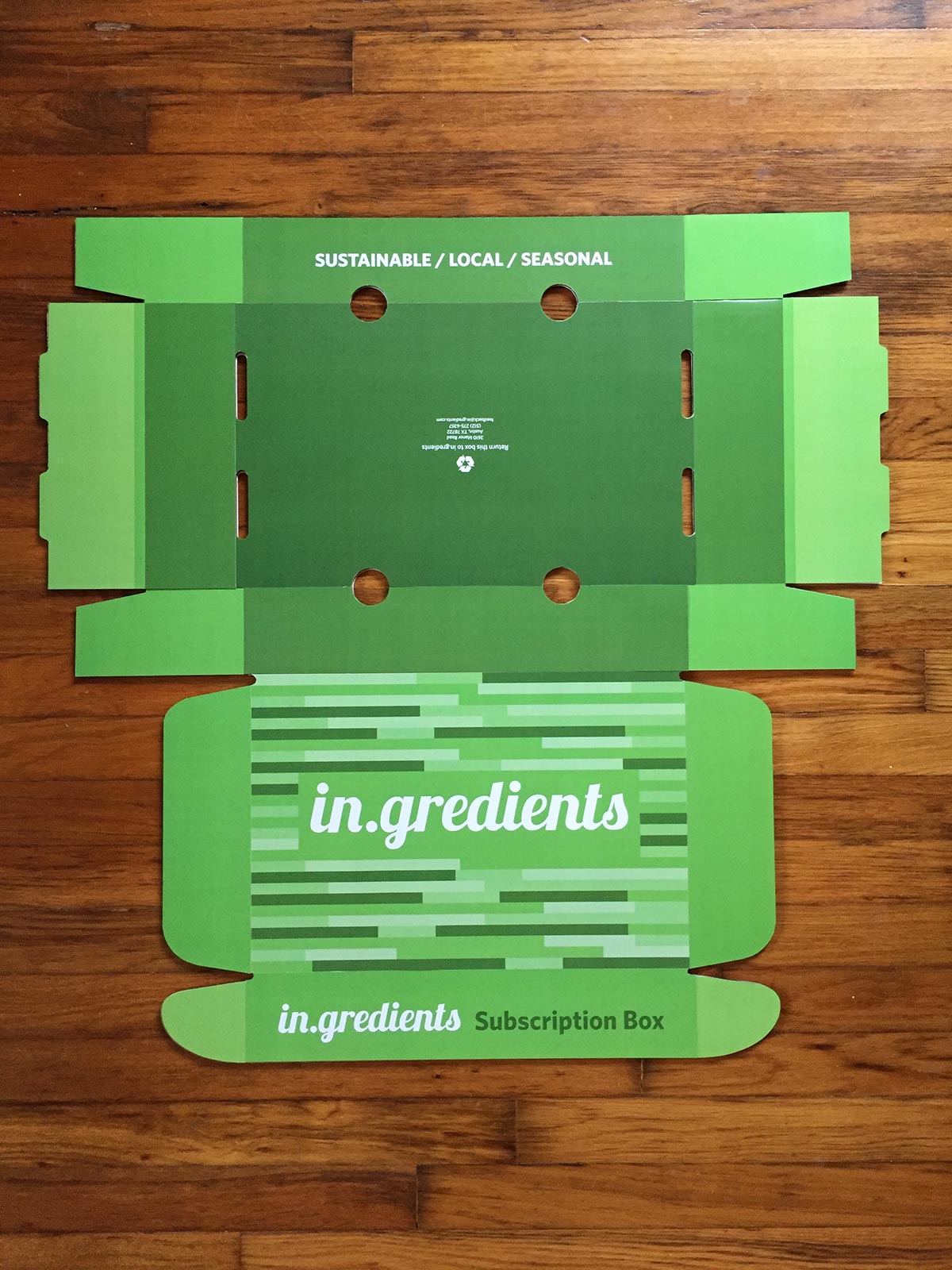
Recipe Cards
Recipe cards will be included in each box and will provide a list of all the items in the box as well as how to prepare them. Recipes will be prepared by the staff. The 3×5in cards will be printed front and back and produced in-house as needed to reduce waste and cost.
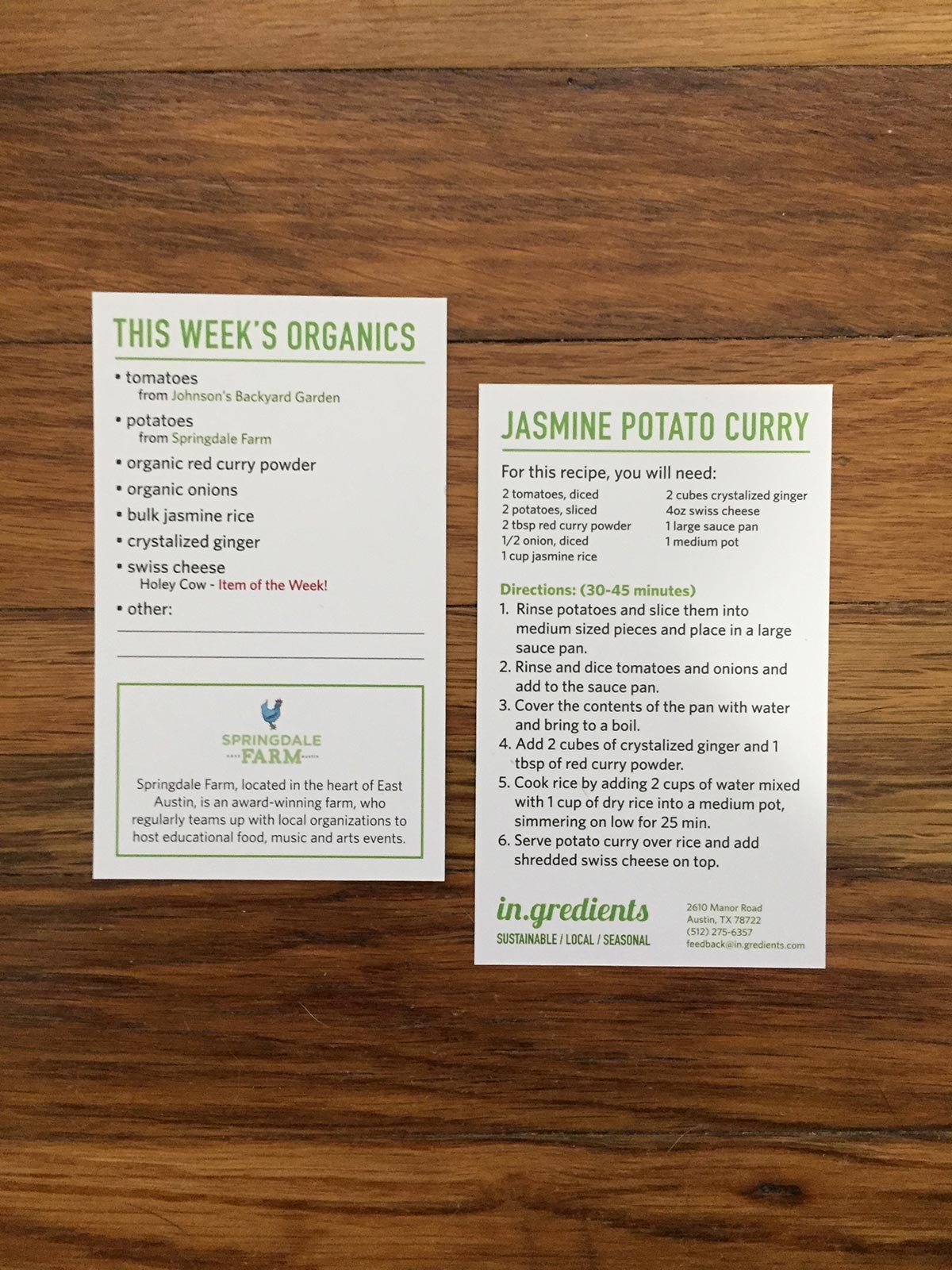
Glass Jars
Etched jars share the ethos with customers and promote reuse inside the store. Jars can be collected from customers, washed, etched to keep costs low. They will be used for holding wet and loose items in subscription boxes. A sticker for the lids have a space for a handwritten date to show when items are picked up as well as a space for a plu# for item identification. The jars will be weighed and the tare value etched onto the jar itself to make shopping easier and also reduce the amount of sticker trash created at the tare station.
The etching makes the jar more special and gives the customer a reason to keep the jar rather than only use it once. Since the jar is branded instead of generic, the customer will feel more attachment to the in.gredients brand and be more likely to return there to fill the jar with more bulk items.
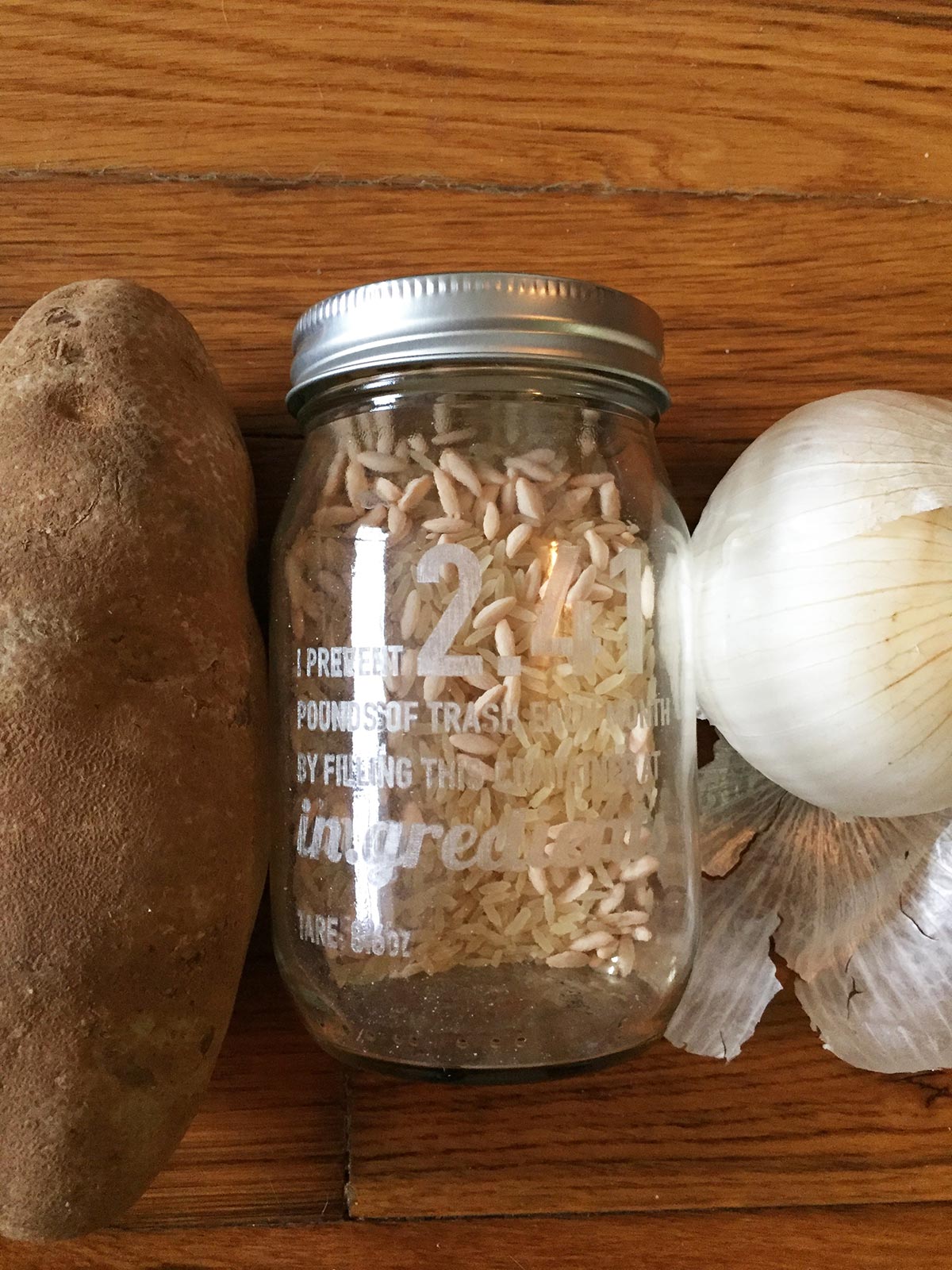
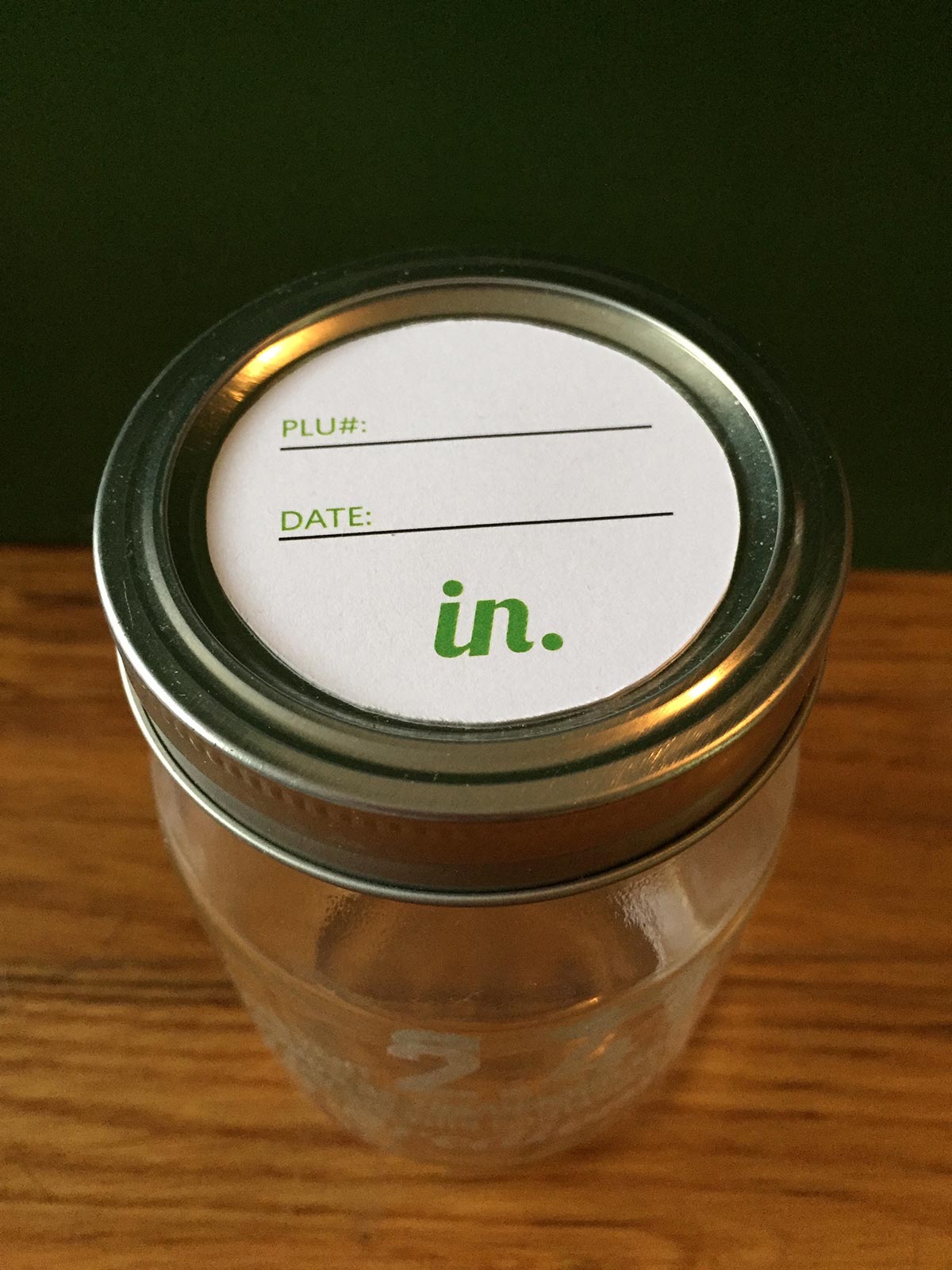
Jar Message Schedule
The jars can contain a variety of messaging options that depict various aspects of the store ethos. Some jars are more about waste prevention, some jars touch on the items from the banned ingredients list, and some jars promote the local and community practices of sustainable farming.
Since jars come in many different sizes, the messages can be tailored in size and dimension to fit any size jar. Since the jars are etched individually, each specific jar’s attributes can be taken into account without having to resort to a one-size-fits-all solution and a possible restriction on jar types.
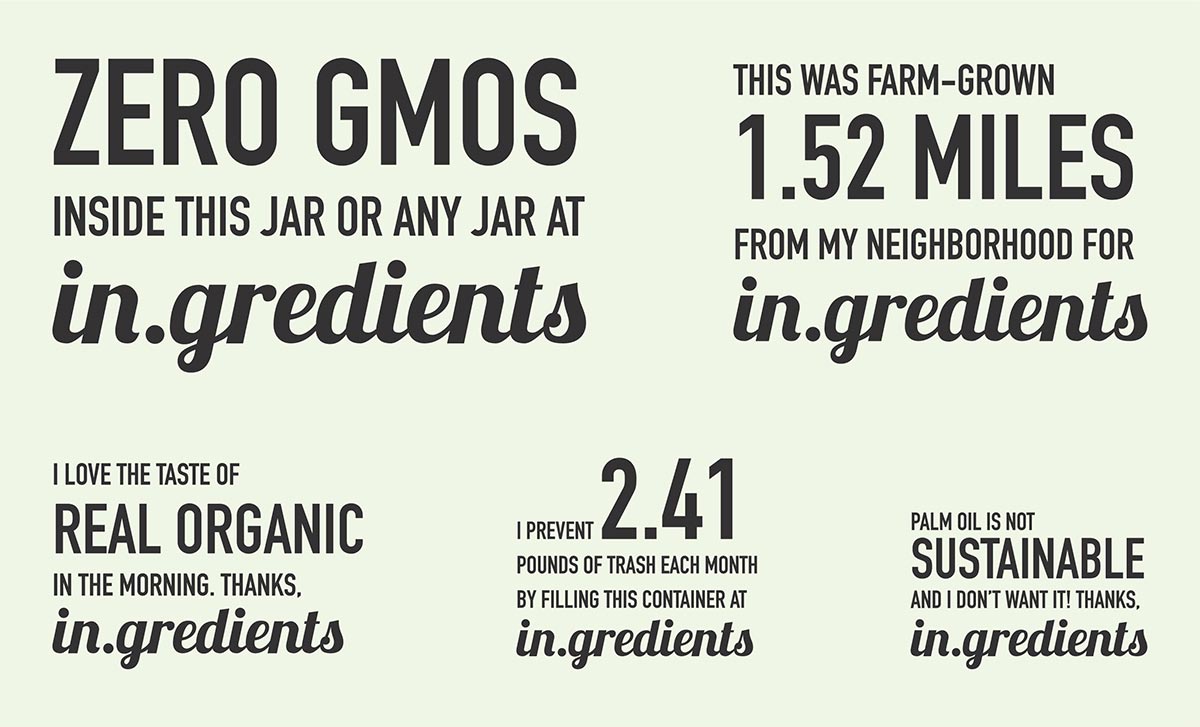
Cotton Bags
Canvas and muslin bags stitched by fair-wage workers will be used to store smaller dry items like beans, rice, and tea. Branding on the bags will reinforce the ethos and make them interesting, so people will keep and reuse them. The bags will be printed using stamps and waterproof ink. Stamps are more easily updated than full runs of commercially printed bags and can be printed on demand to keep initial costs low.
For the subscription box, it is likely that many sizes of cotton bags will be needed for various items. With the stamping system, a large variety of bags can be accommodated using only a few designs and individual stamps.
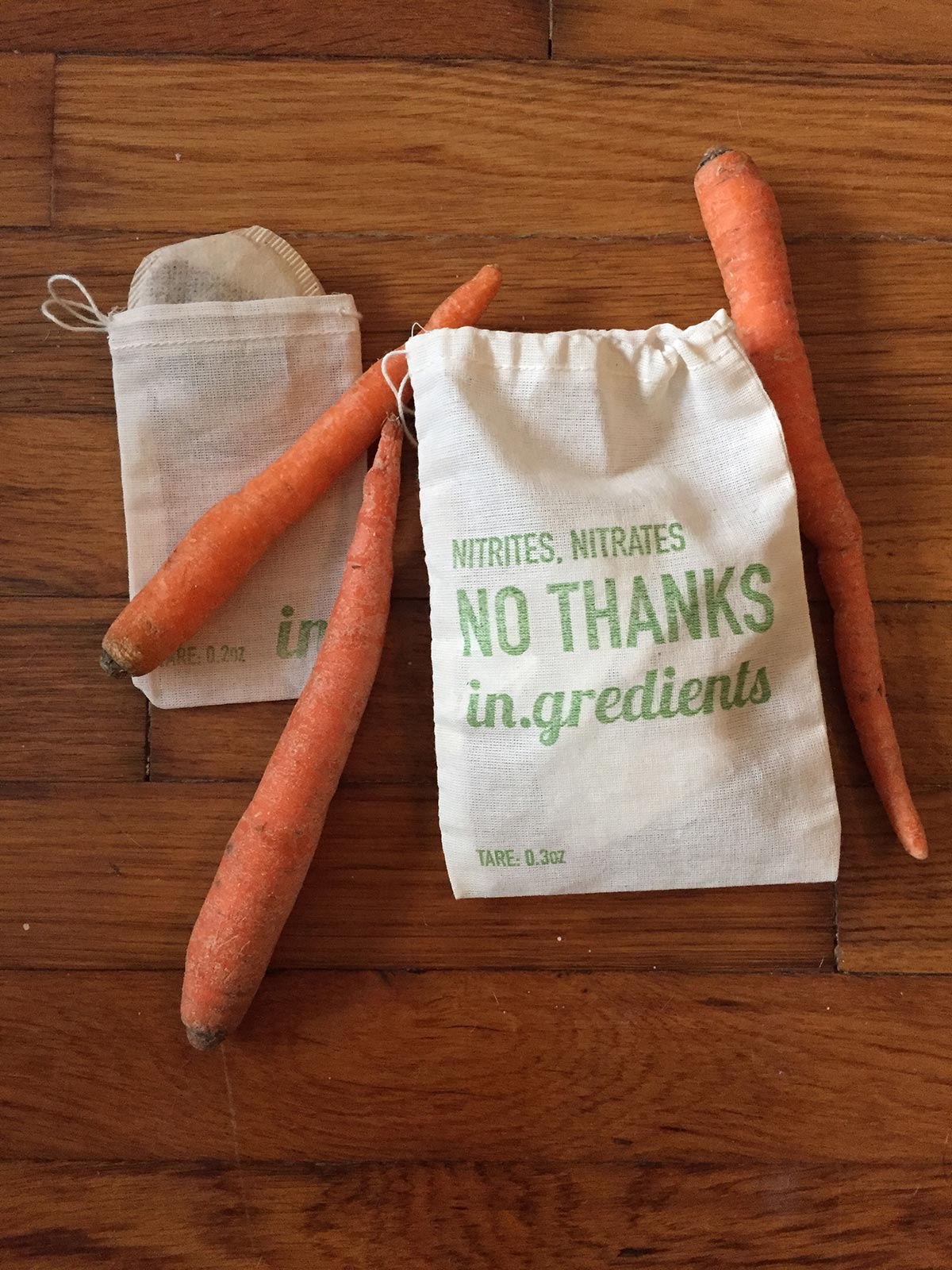
Sign-Up Form
Subscriptions for the boxes can be signed up for online through the in.gredients website. In-store iPads can be used to access the sign-up form for customers who visit in person or during events. Since the box will be picked up from the store and comes in one size, the sign-up process is quite minimal and takes only a few moments.
Customers will first choose the duration of their subscription. Discounts for signing up for longer durations will entice people to select longer subscriptions. Customers can then add any additional information about what they would like in their box and any relevant dietary restrictions. After agreeing to the terms of service, the customer will enter new account information and payment information to complete the process.
After becoming a subscriber, the customer can log into the site and edit any details about their box or cancel their subscription service before the next billing cycle.
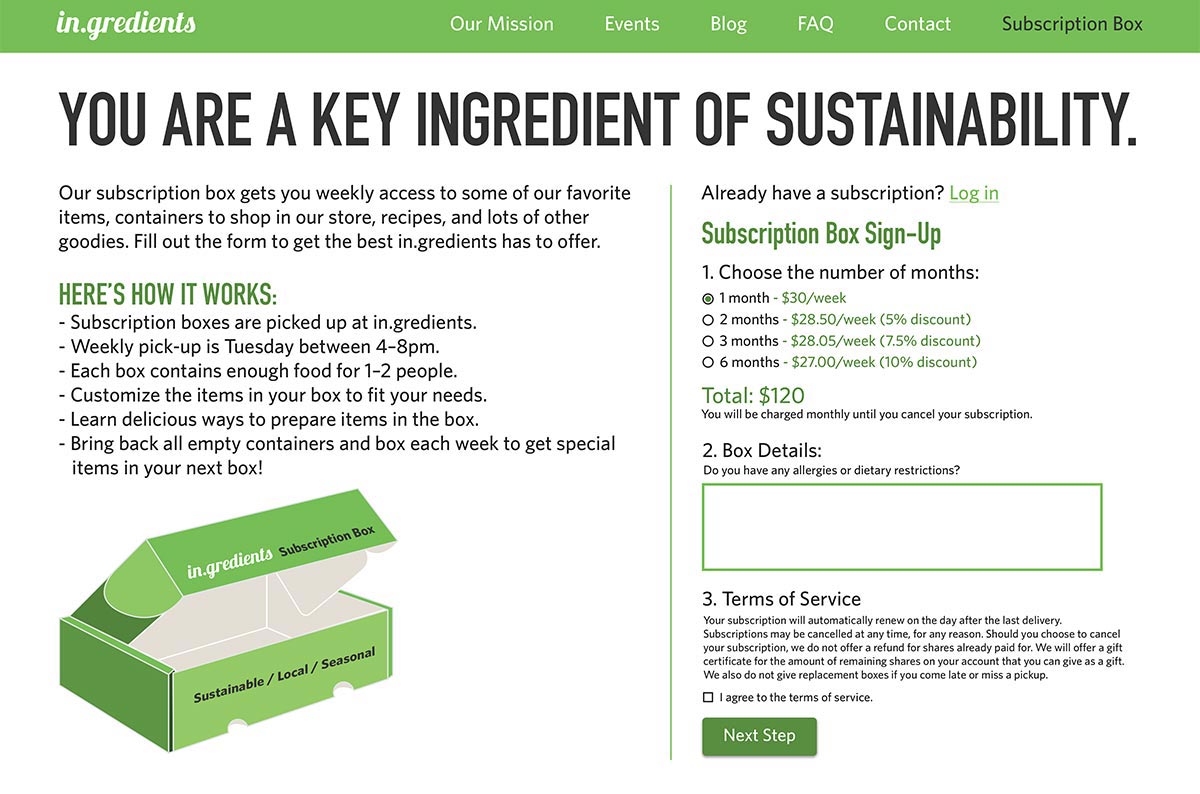
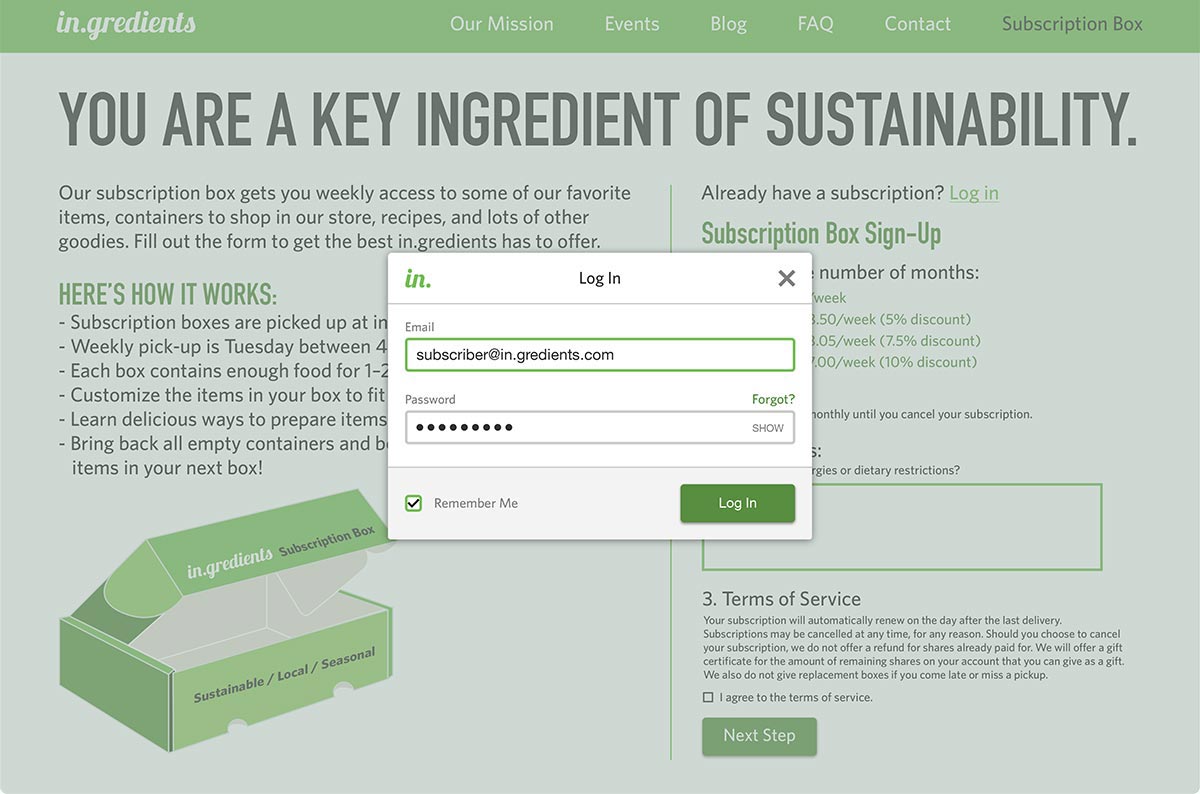
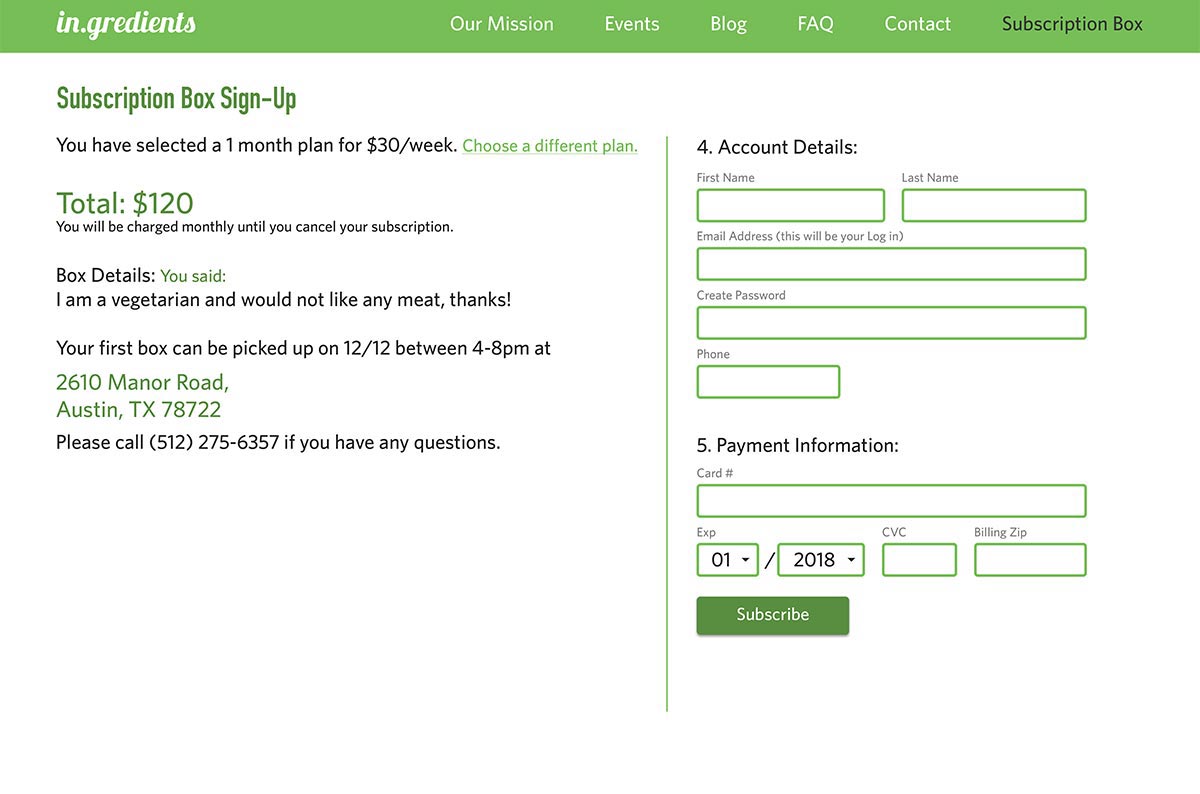
Project Budget
Implementation Plan
The aim of the project is to promote reusable materials, so many costs will be upfront and the project will cost less to continue over time. A few of the items will have variable costs depending on if they are obtained for free through donations or purchased new. Since many items can stand alone, the costs could be spread out over a longer period of time by rolling out different aspects of the subscription box in waves. Muslin and cotton bags could be added after the initial boxes and jars.
Also, any of the designed elements be made available outside of the subscription service to enhance retail sales from customers without subscriptions to promote the store ethos. Subscriptions could be sold to groups of people, such as offices where in.gredients would be responsible for delivering the boxes rather than having them picked up.
Since the box, jars, and bags are modular by nature, they can be used in any number of promotional or awareness campaigns.
For materials costs alone, each box would cost between $7.49 and $11.22 to create with 2 jars, 2 bags, and a recipe card. Over time, the box cost will be reduced when customers return and reuse the contents and offset the cost of buying new boxes and materials each time.
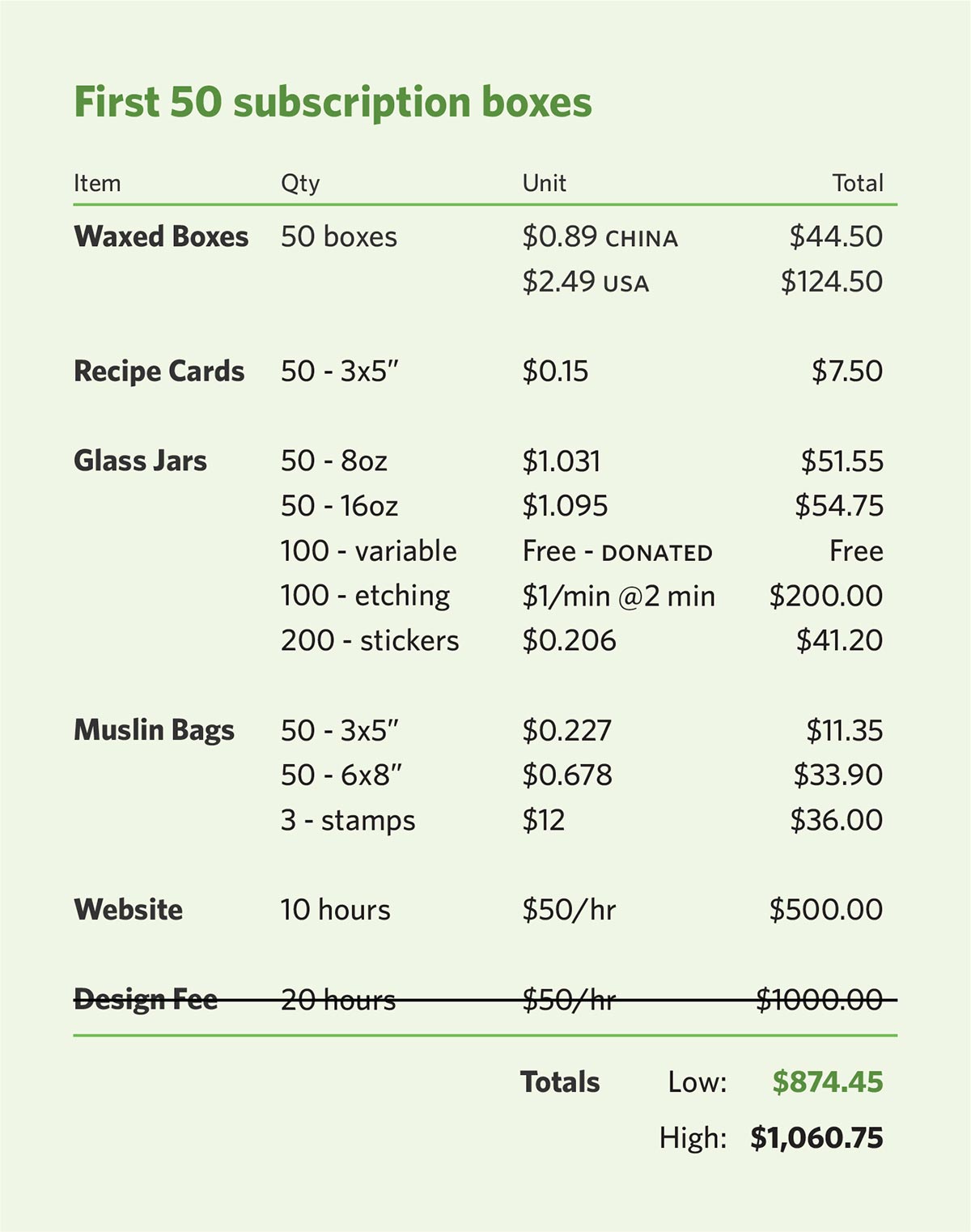
On a final note: the in.gredients store had to close its doors in late 2018. Sustainable grocery stores will always face competition from larger supermarkets.
